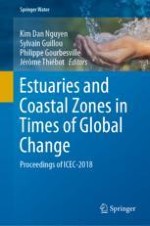2020 | OriginalPaper | Chapter
Shoreline Evolution and Responses to Port Engineering at Lekki Coast, Nigeria
Authors : Yanhong Wang, Jie Shen, Si Zhao
Published in: Estuaries and Coastal Zones in Times of Global Change
Publisher: Springer Singapore
Activate our intelligent search to find suitable subject content or patents.
Select sections of text to find matching patents with Artificial Intelligence. powered by
Select sections of text to find additional relevant content using AI-assisted search. powered by
